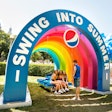
Whereas teambuilding activities are typically intended to get people away from their desks and interacting without their phones and computers, John Chen, the C.E.O. of technology-oriented teambuilding company Geoteaming, makes a new argument. He says that technology—including Twitter, GPS, Facebook, and smartphones—is changing the face of teambuilding. In his new book, 50 Digital Teambuilding Games (Wiley), he shares his tips on how to bring corporate activities indoors to an office setting, with tools like texting and Twitter, as well as how to connect employees located around the world via tablets or computers. We spoke to the former Microsoft employee to get the inside scoop on everything from choosing a cost-effective teambuilding activity to getting anti-tech employees involved.
Why is virtual teambuilding a good idea?
You can [achieve] teambuilding gains without the expense of travel and housing. In addition, [it] can show a team how to use a new technology, or new features that can help them in their everyday jobs.
What's the best way to get older, anti-tech employees on board with these activities?
Start with a technology they already use. If they have a phone, then start with teleconferencing, since it's a format they are used to. If they have a cell phone and are texting, then show them how to use it for teambuilding. If they have email, then perhaps do a digital teambuilding game over email. The key is to take a current technology and teach [employees] one new thing on it so that they have a positive experience, see the benefit, and want to learn more.
What's your favorite quickie teambuilding game or icebreaker from the book?
"Me in 140 Characters or Less." It's a simple networking game where you text, tweet, or email an introduction of yourself in 140 characters or less, and it gets fed immediately to a [projector] screen. I've used it prior to speaking engagements and at teambuilding events many times and it allows people to see what [others] write. It's a great icebreaker, as you get to know a little something about each person.
What should a company consider when choosing a virtual teambuilding activity?
First, make sure that the company has a clear goal for doing a teambuilding event. Is it just for fun, to build morale or specific skills, or to handle the merging of two teams? Next, ensure that all members have access to the same technology. Lastly, make sure to have [the necessary] budget and resources.
How does the cost of virtual teambuilding compare to traditional events?
Currently our programs [at Geoteaming] range from $75 to $205 per person, plus travel and expenses. [However], virtual teambuilding is helping change these price structures. In one case, we were able to do a Goose Chase—a cell phone scavenger hunt—for a client with a smaller budget by consulting, licensing, and training on our system, then having [the client] deliver the program while we assisted online from our home office.
What's the minimum number of people that can participate in an activity? The maximum?
The minimum is one if it's cost effective—we can use virtual teambuilding to coach a single individual one-on-one. We've run an event with 1,750 for our Goose Chase, which produced 3,900 photos in two-and-a-half hours. We'll be breaking records with an event of about 3,500 this summer.
Which activities are the most popular for large groups?
Ah-Ha, a face-to-face activity, is our most popular for large groups. It's a GPS-based scavenger hunt that teaches teambuilding and cross-team collaboration skills, while participants hunt for containers or locations via GPS. Our Goose Chase program is our new favorite and second-highest seller for large groups.
Where do you think virtual teambuilding will be in the next five years?
Ten years ago we envisioned a world where teambuilding would be done entirely online, but it was too early. Now, with enough Facebook users for it to be the fifth-largest country, and 4.2 billion texters in the world, digital teambuilding is ready to be adopted. It will only increase within the next five years—we hope to see more teambuilding online, catching up and surpassing real-world gaming work by producing games with work value, creating measurable results with clients, and the term "gamification" being a critical buzzword to worker productivity and effectiveness.



















